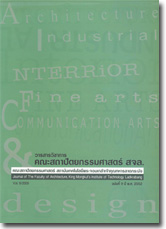การศึกษาวิธีการลดความชื้นของอากาศภายในบ้านแถว เขตกรุงเทพมหานคร กรณีศึกษา : บ้านแถว ทาวน์เฮ้าส์ 3 ชั้นหมู่บ้านศุภาลัยวิลล์ ถนนรัชดาภิเษก
Main Article Content
Abstract
บทคัดย่อ
งานวิจัยนี้เป็นการศึกษาความเป็นไปได้ในการลดและการเพิ่มความชื้นของอากาศภายในบ้านแถว โดยบ้านแถวที่นำมาใช้เป็นกรณีศึกษา ได้มีการแบ่งพื้นที่ภายในออกเป็น 3 ส่วน คือส่วนต้อนรับ , ส่วนทำอาหารและส่วนพักผ่อน โดยมุ่งเน้นศึกษาวิธีการลดความชื้นที่เกิดจากกิจกรรมภายในบ้านแถว ซึ่งแต่ละรูปแบบของการทดลองอ้างอิงมาจากหลักในการลดความชื้น ดังนี้
การทดลองที่ 1 ที่สภาวะปกติ ไม่มีการควบคุมความชื้น เพื่อเป็นแบบอ้างอิงเปรียบเทียบประสิทธิภาพกับการทดลองอื่นๆ
การทดลองที่ 2 การระบายอากาศ (Ventilation) พาความชื้นไปยังส่วนอื่น โดยการทดสอบกำหนดความเร็วลม 2 ระดับ คือที่ความเร็วลม 0.6 m/s และ 2.4 m/s (วัดที่ระยะ 10 cm. จากพัดลม) เพื่อเปรียบเทียบผลการทดลอง
การทดลองที่ 3 สารดูดความชื้น (Desiccant) เพื่อดูดซับความชื้นในอากาศ โดยการทดสอบเลือกใช้สารดูดความชื้น; Eco Dry ขนาด 1 Kg และ 2 Kg เพื่อเปรียบเทียบผลการทดลอง
จากการวิจัยสรุปคุณสมบัติและข้อจำกัดของการทดลองในแต่ละกรณี
1. การระบายอากาศ เป็นวิธีที่สามารถลดความชื้นได้ทุกช่วงเวลาแต่เนื่องจากการทดลองนี้การะบายอากาศเป็นเพียงการย้ายอากาศชื้นจากจุดหนึ่งไปยังอีกจุดหนึ่ง เท่านั้น การที่จะทำให้ความชื้นลดลงได้จริงจึงต้องมีการถ่ายเทอากาศชื้นออกนอกหุ่นจำลอง
2. สารดูดความชื้น Eco Dry สามารถลดความชื้นได้อย่างรวดเร็วและมีประสิทธิภาพ แต่มีข้อจำกัดในเรื่องของความอิ่มตัว และราคาค่อนข้างแพงในการนำมาใช้ภายในอาคาร จึงควรลองใช้วัสดุท้องถิ่น เช่นถ่านจากกะลามะพร้าว ไม้โกงกาง ฯลฯ ซึ่งมีคุณสมบัติในการดูดความชื้นมาทดแทน
คำสำคัญ : ความชื้น, บ้านแถว, การระบายอากาศ, สารดูดความชื้น Eco Dry
Abstract
This project proposes to study a process of dehumidification of moist air of a row house, In specific: a 3 storey row house, Supalai ville on Ratchadapisak road. The internal area can be divided into 3 main functions; Living area , Pantry area and Privacy area. The objective is stressed to study of desiccant the behavior of moist air that occur from activities in building.
Simulation 1 Normal : not control humidity, it refer to compare efficiency with others.
Simulation 2 Ventilation : To move moist air to another place. By test with wind speed 2 levels at 0.6
m/s and 2.4 m/s (measure at 10 cm. from fan) to compare efficiency humid control in
different wind speed.
Simulation 3 Desiccant : by test with Eco Dry 1 Kg and 2 Kg to compare efficiency of different desiccant.
Conclusion of Benefit and Limited of each factors
1. Ventilation is a method that can reduce humid in the air all of time but in this experiments ventilation is moved moist air from a place to another place. It dose not obliterate moist air. Procedure that reduce moist air should be created outlet for removing moist air to outside
2. Eco Dry Desiccant is a method that reduce moist air quickly in a period of time. It has limit of point of saturation and cost of desiccant. It can use local material such as coal from wood, coconut, etc instead.
Key words : Humidity, A row house, Ventilation, Eco dry desiccant
Article Details
This work is licensed under a Creative Commons Attribution-NonCommercial-ShareAlike 4.0 International License.
Copyright Transfer Statement
The copyright of this article is transferred to Journal of The Faculty of Architecture King Mongkut's Institute of Technology Ladkrabang with effect if and when the article is accepted for publication. The copyright transfer covers the exclusive right to reproduce and distribute the article, including reprints, translations, photographic reproductions, electronic form (offline, online) or any other reproductions of similar nature.
The author warrants that this contribution is original and that he/she has full power to make this grant. The author signs for and accepts responsibility for releasing this material on behalf of any and all co-authors.


